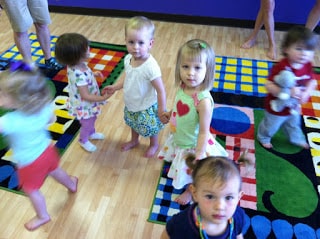Parenting Tip: Add music to your daily routine to boost your toddlers’ memory! Why? Short-term memory has the ability to hold about seven bits of information. But, when patterns and related groupings of information are bound together as a unit, the volume of material stored increases. Patterns then become an important avenue for recall and memory (Rhythms of Learning – Chris Brewer & Don G. Campbell).
Learning to recognize patterns means information—language, music, and movement—can be decoded, organized, and remembered more easily. As children develop pattern-recognition abilities, their learning potential is greatly enhanced because their brains are building skills in prediction and categorization, which can be applied to any new information they encounter.
How?
Enjoy a movement game!
Next, create a family & friends ‘flip book,’ with your child!
Cue up a favorite song from Kindermusik’s Family & Friends CD (maybe Hop Up, My Baby?), and create a movement pattern, as a family! Bounce to the verses, and hop up, on the matching lyrics. What if you walked & jumped, instead? Or tiptoed & stretched?
Or… Want to Learn More? On our blog – learn why musicians have an advantage, when it comes to memory.
And, enjoy a free ‘memory game,’ with your child.
Kindermusik’s 7-year Continuum: Kindermusik babies use songs to remember when it is time for class to begin, when it is time for rocking together, and when it is time to say goodbye. As a toddler, your child starts focusing on details in the music & lyrics, to know when it is time to ‘Hop Up!’ Kindermusik preschoolers take this musical memory a step further, by listening for the right place in the song to play their instruments (is it time for the ‘see-saw-see’ sound, yet? How many beats before I tap the triangle?) Big kids in Young Child classes use their musical memories to know which note comes next on their glockenspiel, by reading notation on a staff, singing the melody from memory, then transferring those notes to the glockenspiel as they sing.


Leave a Reply